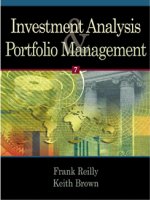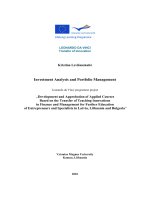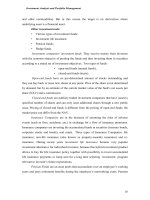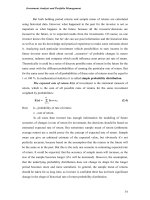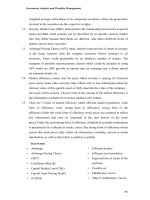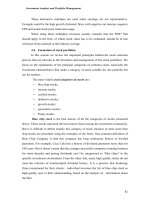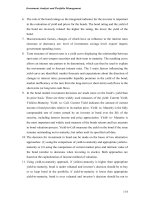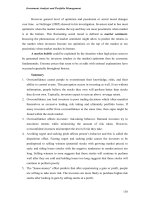Investment analysis and portfolio management
Bạn đang xem bản rút gọn của tài liệu. Xem và tải ngay bản đầy đủ của tài liệu tại đây (250.44 KB, 26 trang )
Investment Analysis and
Portfolio Management
Lecture 7
Gareth Myles
The Capital Asset Pricing Model
(CAPM)
The CAPM is a model of equilibrium in the
market for securities.
Previous lectures have addressed the
question of how investors should choose
assets given the observed structure of returns.
Now the question is changed to:
If investors follow these strategies, how will returns
be determined in equilibrium?
The Capital Asset Pricing Model
(CAPM)
The simplest and most fundamental model of
equilibrium in the security market
Builds on the Markowitz model of portfolio choice
Aggregates the choices of individual investors
Trading ensures an equilibrium where returns
adjust so that the demand and supply of
assets are equal
Many modifications/extensions can be made
But basic insights always extend
Assumptions
The CAPM is built on a set of assumptions
Individual investors
Investors evaluate portfolios by the mean and
variance of returns over a one period horizon
Preferences satisfy non-satiation
Investors are risk averse
Trading conditions
Assets are infinitely divisible
Borrowing and lending can be undertaken at the riskfree rate of return
There are no taxes or transactions costs
Assumptions
The risk-free rate is the same for all
Information flows perfectly
The set of investors
All investors have the same time horizon
Investors have identical expectations
Assumptions
The first six assumptions are the Markowitz
model
The seventh and eighth assumptions add a
perfect capital market and perfect information
The final two assumptions make all investors
identical except for their degree of risk
aversion
Direct Implications
All investors face the
same efficient set of
portfolios
rp
rf
r MVP
σ MVP
σp
Direct Implications
All investors choose
a location on the
efficient frontier
The location depends
on the degree of risk
aversion
The chosen portfolio
mixes the risk-free
asset and portfolio M
of risky assets
Separation Theorem
The optimal combination of risky assets is
determined without knowledge of preferences
All choose portfolio M
This is the Separation Theorem
M must be the market portfolio of risky assets
All investors hold it to a greater or lesser extent
No other portfolio of risky assets is held
There is a question about the interpretation of this
portfolio
Equilibrium
The only assets that need to be marketed are:
The risk-free asset
A mutual fund representing the market portfolio
No other assets are required
In equilibrium there can be no short sales of
the risky assets
All investors buy the same risky assets
No-one can be short since all would be short
If all are short the market is not in equilibrium
Equilibrium
Equilibrium occurs when the demand for assets
matches the supply
This also applies to the risk-free
Borrowing must equal lending
This is achieved by the adjustment of asset
prices
As prices change so do the returns on the assets
This process generates an equilibrium structure
of returns
The Capital Market Line
All efficient portfolios
must lie on this line
rM − r f
Slope =
Equation of the line
rM
σM
rM − rf
rp = rf +
σM
rp
σ p
rf
σM
σp
Interpretation
rf is the reward for "time"
Patience is rewarded
Investment delays consumption
rM − rf is the reward for accepting "risk"
σM
The market price of risk
Judged to be equilibrium reward
Obtained by matching demand to supply
Security Market Line
Now consider the implications for individual
assets
Graph covariance against return
The risk on the market portfolio is
σM
The covariance of the risk-free asset is zero
The covariance of the market with the market is
σ M2
Security Market Line
Can mix M and the riskfree asset along the line
If there was a portfolio
above the line all
investors would buy it
No investor would hold
one below
The equation of the line
is
rM − r f
ri = r f +
σ iM
2
σ M
rp
rM
M
rf
σ M2
σ iM
Security Market Line
σ iM
= 2
σM
Define
The equation of the line becomes
β iM
[
]
ri = rf + rM − rf β iM
This is the security market line (SML)
Security Market Line
There is a linear
trade-off between
risk measured by β iM
and return ri
In equilibrium all
assets and portfolios
must have risk-return
combinations that lie
on this line
rp
rf
β iM
Market Model and CAPM
Market model uses
β iI
CAPM uses β
iM
β iI is derived from an assumption about the
determination of returns
β iM
it is derived from a statistical model
the index is chosen not specified by any underlying
analysis
is derived from an equilibrium theory
Market Model and CAPM
In addition:
I is usually assumed to be the market index, but in
principal could be any index
M is always the market portfolio
There is a difference between these
But they are often used interchangeably
The market index is taken as an approximation
of the market portfolio
Estimation of CAPM
Use the regression equation
[
]
ri − r f = α iM + β iM rM − r f + ε i
Take the expected value
[
]
[
E ri − r f = α iM + β iM E rM − r f
The security market line implies
It also shows
α iM = 0
α iI = [1 − β iM ] r f
]
CAPM and Pricing
CAPM also implies the equilibrium asset prices
The security market line is
[
]
ri = r f + rM − r f βiM
But
pi (1) − pi ( 0)
ri =
pi ( 0 )
where pi(0) is the value of the asset at time 0
and pi(1) is the value at time 1
CAPM and Pricing
So the security market line gives
p i (1) − p i ( 0)
= r f + β iM rM − r f
p i ( 0)
[
]
This can be rearranged to find
p i (1)
p i ( 0) =
1 + r f + β iM rM − r f
The price today is related to the expected
value at the end of the holding period
[
]
CAPM and Project Appraisal
Consider an investment project
It requires an investment of p(0) today
It provides a payment of p(1) in a year
Should the project be undertaken?
The answer is yes if the present discounted
value (PDV) of the project is positive
CAPM and Project Appraisal
If both p(0) and p(1) are certain then the riskfree interest rate is used to discount
The PDV is
p(1)
PDV = − p( 0 ) +
1+ rf
The decision is to accept project if
p(1)
p( 0) <
1+ rf
CAPM and Project Appraisal
Now assume p(1) is uncertain
Cannot simply discount at risk-free rate if
investors are risk averse
For example using
p (1)
PDV = − p( 0) +
1+ rf
will over-value the project
With risk aversion the project is worth less than
its expected return
U ( p (1)) > EU ( p (1))
